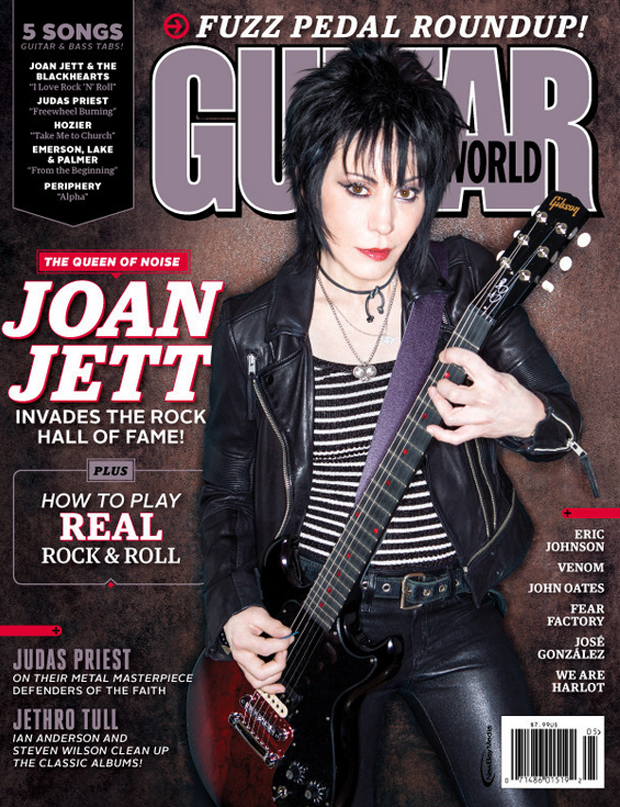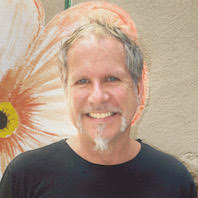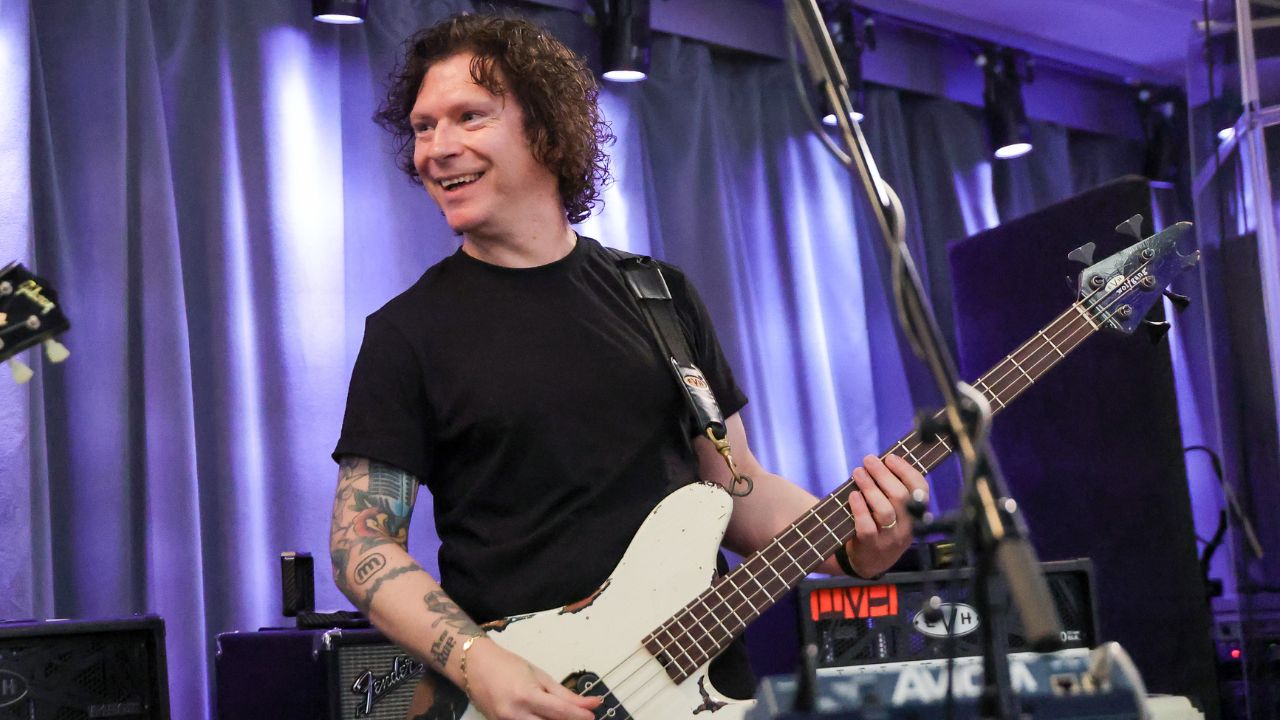Joan Jett Talks Rock and Roll Hall of Fame, Lou Reed and "I Love Rock ’N’ Roll"

Girl’s Got Rhythm: Joan Jett has been banging out some of rock’s greatest power chords since the age of 15. With her induction into the Rock and Roll Hall of Fame, there’s only one thing you need to know—she still loves rock and roll.
Joan Jett looks perfect. In other words, she looks exactly the way you want Joan Jett to look.
With her iconic black shag and eyeliner, she saunters into the Guitar World photo studio wearing a variation on a rock and roll uniform she had worn almost her entire life: a tight black sleeveless shirt, black jeans and black motorcycle boots, all of it topped with a kick-ass leather jacket.
And if you have to ask about the color of her jacket, you clearly haven’t been paying much attention.
The last few years have been pretty supersonic for Jett and her band the Blackhearts. Since releasing the critically acclaimed Unvarnished album in late 2013, which featured the hit “Any Weather,” co-written with Foo Fighters frontman Dave Grohl, she has been touring up a storm while snagging honors right and left, like the Revolver Golden God award and the Alternative Press Icon Award.
To complete the trifecta, this month she is being inducted into the Rock and Roll Hall of Fame, long considered music’s ultimate validation. Not bad for a veteran celebrating her fourth decade in the biz.
Truth is, Joan Jett’s entire career is nothing short of miraculous, especially when you consider just how difficult it was for her to simply get out of the starting gate.
“My parents got me a guitar for Christmas when I was 13 and I went to take lessons,” Jett says in her distinctive sandpapery voice. “I told the teacher I wanted to learn how to play rock and roll, and because I was just a naïve kid, I thought he was going to be able to show me in one lesson! I didn’t know that you had to learn the ropes. If he would’ve explained that to me, it would’ve been fine, but instead he said something far worse. He told me, ‘Girls don’t play rock and roll,’ and then tried to teach me ‘On Top of Old Smokey.’ ”
In response, Joan grabbed her guitar and stormed out never to return. A mere two years later, at the age of 15, Jett proved her teacher—and every other sexist naysayer—wrong when she formed the Runaways, a groundbreaking all-female rock band, best known for their 1976 hit “Cherry Bomb.” The band didn’t last very long, but their music and exploits became legendary to multiple generations, partly due to The Runaways, a successful movie biopic about the band released in 2010 starring Kristen Stewart as Jett.
While the Runaways were crucial to Joan’s development, it was her solo career that made her a household name. A succession of Top 40 hits including “Bad Reputation,” “Crimson & Clover,” “Do You Wanna Touch Me (Oh Yeah)” and the 1981 monster smash “I Love Rock ’N’ Roll” cemented her status as the quintessential queen of noise. And the accompanying MTV videos didn’t hurt either.
If you had to design a woman rocker from the ground up, it would probably look a helluva lot like Joan in videos like 1988’s “I Hate Myself for Loving You.” With her white Gibson Melody Maker slung low, she was sleek, tough and sexy—the living embodiment of the ultimate badass girl with a guitar.
Image aside, as a musician, she’s no slouch either. One former Blackheart bandmate recently commented, “You could build a fortress on the foundation of Joan’s rhythm hand.” True, that. Her power chords detonate with the shattering force and clarity of a nail bomb going off at Tiffany’s, and outside of AC/DC’s Malcolm Young or Keith Richards, it’s hard to think of anybody that can lay down a groove like Joan. What’s her secret? That’s partly what we’re here to find out.
It’s interesting to note that Joan rarely uses the word “rock” to describe her favorite music. Instead, she almost always refers to it by its somewhat antiquated and more formal name, “rock and roll.” Maybe it’s just out of habit, but perhaps it’s out of respect. It’s clear from our conversation Joan has a deep reverence for rock and roll. One thing is very certain: she clearly loves it.
How do you feel about being inducted into the Rock and Roll Hall of Fame?
It’s awesome and an honor. The Hall has inducted so many people that I look up to, so it’s incredible to be counted among them. That said, it’s not something I ever aspired to. When I write songs or play music it’s not something I really think about. You just want to tour and get your songs out. I mean this in the best way, but the Rock and Roll Hall of Fame is just an aside. The part that I think is really positive about the Hall of Fame is that rock isn’t being acknowledged at the Grammy’s and other music awards shows, so it’s cool that we have our own moment. And I really hope it stays focused on rock, because all other music already gets acknowledged on all the other shows.
You are being inducted with two other musicians that are cut from the same cloth. Both Lou Reed and Billie Joe Armstrong of Green Day are great singer/rhythm guitarists. Did you ever hang with Lou and his legendarily decadent crew in the Seventies?
No, unfortunately. In the early days, I was based on the West Coast and he was in New York City. However, I remember buying Transformer with “Walk on the Wild Side” as a kid and I was really impressed with how it freaked people out! People would say he couldn’t carry a tune, but that wasn’t the point. He was a storyteller and singing about things nobody else was talking about at the time. I finally met Lou at a Rock and Roll Hall of Fame ceremony a few years ago. We were sitting at different tables near each other, and that particular year there were a few acts being inducted that weren’t really rock and roll. We just kept looking at each other, making faces. It was a special moment between the two of us, because no one else saw what we were doing. [laughs]
When you were in the Runaways, you actually covered Lou Reed’s song “Rock and Roll,” but you did it more in the style of Mitch Ryder’s great 1971 version of the song. Yeah, the weird thing is, we weren’t even aware of Lou Reed’s version at that time. We had heard Mitch Ryder’s version and fell in love with the great guitar riff that kicks off the song so we focused on that. A couple years later I started listening to Lou’s original recording, and as a rhythm guitar player I started liking it more, because it had a weird rhythm to it. It has an extra bar tucked in, which is something I always find intriguing.
“I Love Rock ’N’ Roll,” your biggest hit, actually has that extra bar in it.
The two songs are connected in a funny way. I first heard “I Love Rock and Roll” in England while the Runaways were touring. It was the B-side of a single by a group called the Arrows and I immediately thought it sounded like a hit. I played it for the band, but they didn’t want to do it because we had just recorded “Rock ’N’ Roll” and they didn’t think it was a good idea to have two songs on the same album with the words “rock ’n’ roll” in the title, so we didn’t do it. I thought to myself, I’ll just stick it in my back pocket, and maybe we’ll revisit in another album or two. Anyway, the band broke up, I ended up recording it for my solo album and the rest is history.
You were only 15 when you formed the Runaways and had been playing guitar for just a couple of years, yet your rhythm playing was already rock-solid. Was that just something that came naturally?
After my first guitar teacher tried to discourage me from playing rock and roll, I went out and bought one of those teach yourself how to play guitar books and learned all the basic open chords and barre chords and started playing along with records. The first songs I was able to figure out were things like “Smoke on the Water” by Deep Purple, Black Sabbath songs like “Iron Man” and “Sweet Leaf” and “Bang A Gong” by T. Rex.
I immediately gravitated to power chords because I found I could be more rhythmically accurate with them and they sounded closer to the music I was listening to. But to answer your question, I never really thought about whether I was any good or could keep a beat, I just played along to albums. My bigger problem was that I was alone—I couldn’t find other kids to rock out with.
Eventually my family moved from Rockville, Maryland, to California, which was really great because I knew there had to be other girls in Los Angeles that could play music and maybe I could form a band. That idea really motivated me. Not long after, I met Sandy West, who would eventually be the drummer for the Runaways. She was a big, strong girl and her idol was Led Zeppelin’s John Bonham and she played like him. We set up in the rec room of her house and just started to jam, and the sound was so powerful we knew we were on to something. We said, “We gotta go find some other girls.” I knew pretty quickly that I was a rhythm guitar player and not a lead player—I just wasn’t interested in that.
This is an excerpt from the all-new May 2015 issue of Guitar World. For the rest of the story, head here.Photo: Jimmy Hubbard

All the latest guitar news, interviews, lessons, reviews, deals and more, direct to your inbox!
A long time ago in a galaxy far, far away Brad was the editor of Guitar World from 1990 to 2015. Since his departure he has authored Eruption: Conversations with Eddie Van Halen, Light & Shade: Conversations with Jimmy Page and Play it Loud: An Epic History of the Style, Sound & Revolution of the Electric Guitar, which was the inspiration for the Play It Loud exhibition at the Metropolitan Museum of Art in New York City in 2019.

